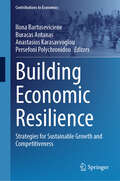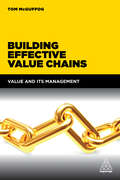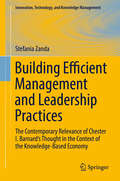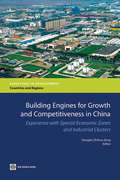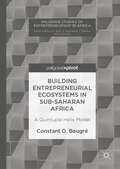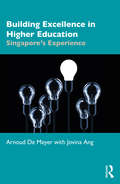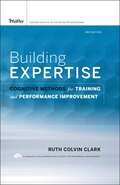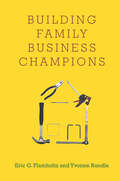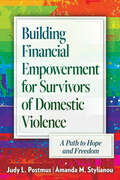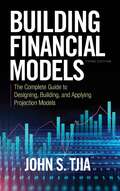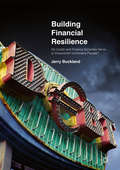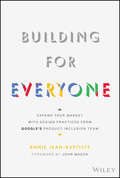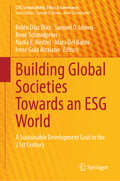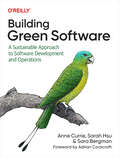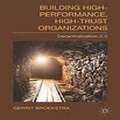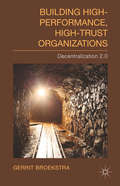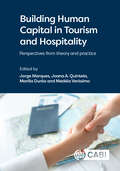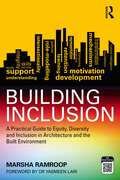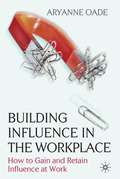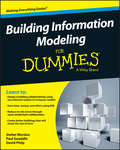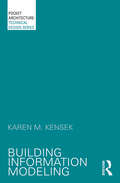- Table View
- List View
Building Economic Resilience: Strategies for Sustainable Growth and Competitiveness (Contributions to Economics)
by Anastasios Karasavvoglou Persefoni Polychronidou Ilona Bartuseviciene Buracas AntanasThis book offers a comprehensive analysis of the key topics presented at the International Conference on the Economies of the Balkan and Eastern European Countries (EBEEC), held at Mykolas Romeris University in Vilnius, Lithuania, on May 17–19, 2024. Bringing together scholarly perspectives, this book explores resilient and sustainable economic developments across various sectors and regions. It highlights the importance of fostering globally competitive transitions that extend beyond traditional efficiency and productivity measures. The book begins with discussions on resilient development patterns, progresses to sustainability-driven innovations that enhance environmental responsibility across industries, and concludes with insights into the role of sustainable investments in navigating economic turbulence. By presenting a range of analytical frameworks, this book provides valuable insights into building transformative capacities to manage unexpected shocks in both local and global economic contexts. It serves as a vital resource for scholars, policymakers, and practitioners seeking to navigate complex and evolving economic landscapes.
Building Effective One-on-One Work Relationships
by Linda A. HillAddresses how to build effective one-on-one work relationships. Spells out the importance of analyzing your network and understanding on whom you are dependent. Also provides some criteria for assessing the quality of your relationships. Finally, it discusses how to manage conflict based on the Senge Model of advocacy, inquiry, and mental models, all of which encourage people to uncover their assumptions.
Building Effective Value Chains: Value and its Management
by Tom McguffogThe value chain describes the full range of activities that firms and workers do to bring a product from its conception to its end use and beyond. This includes activities such as design, production, marketing, distribution and support to the final consumer. Value chain activities can occur within or between firms, within a single geographical location or spread across wider areas, and can produce goods or services. The overall goal of the value chain is to create value that exceeds the cost of providing a product or service, thus generating a profit margin. The concept of the value chain is at the early stages of a journey and many people still think conventionally. Building Effective Value Chains challenges this notion, helping people to think differently and to pursue the right goal in business.Building Effective Value Chains gives practical, easily understood advice on enhancing the value chain, supported by case studies from both the public and private sector that illustrate how the methodology that can be applied to different value chains. The book also considers the commercial value of the value chain as well as the academic origins of the value chain. Author Tom McGuffog shares his knowledge and experience from working in Rowntree and Nestle, the UK Procurement Agency, the Defence Logistics Organisation, and NHS Purchasing and Supply. Taking a global perspective, the issues discussed in this book are applicable internationally. Building Effective Value Chains includes executive summaries at the end of each chapter, useful online materials, and a comprehensive list of references.
Building Efficient Management and Leadership Practices: The Contemporary Relevance of Chester I. Barnard's Thought in the Context of the Knowledge-Based Economy (Innovation, Technology, and Knowledge Management)
by Stefania ZandaThis book examines the relationships among leadership, the quality of the management process and business results. Drawing from the pioneering contributions of Chester I. Barnard, this book defines the role and characteristics of an effective and efficient manager in the new knowledge economy. This book also examines the relevance of Barnard's work on modern studies in economics and business administration. Chester I. Barnard considered the company to be a complex socio-economic system, oriented towards general aims. A company's behavior is rational if its constituent elements and management models are planned, organized, guided and regulated in order to create and maintain a cooperative system that combines efficiency and effectiveness. In this book, the conceptual construction of Barnard's management theory is represented by a synthetic scheme in which the various components of the business process (including leadership) and their influences on the outcome variables of the company are linked as a system. This approach makes this book appealing to academics, scholars and professionals in business, management, administration and knowledge management.
Building Engines for Growth and Competitiveness in China
by Douglas Zhihua Douglas Zhihua ZengIn the past 30 years, China has achieved an unprecedented development "miracle" in human history. How did China achieve this? What are the key drivers for such a rapid growth? And most importantly, what can be learned from China's success? While many factors could be identified to explain China's success, it is no doubt that the numerous Special Economic Zones (SEZs) and industrial clusters that emerged after the country's reforms are two important engines that have been driving China's rapid development. The key experiences of China's SEZs and industrial clusters could be best summarized as: gradualism with experimental approach; strong commitment; and an active facilitating state with strong pragmatism. This book reviews the development experiences of China's SEZs and industrial clusters through extensive research, field visits, and case studies in an attempt to benefit the policy-makers, development practitioners, scholars from developing countries, and the global development community in general. It contains five detailed case studies - three SEZs in the broadest sense (Shenzhen, Tianjin and Kunshan) and two industrial clusters (Wenzhou footwear cluster in Zhejiang and Xiqiao textile cluster in Guangdong). This volume represents the most comprehensive volume to date on China's experiences with both its SEZ and cluster experiences.
Building Entrepreneurial Ecosystems in Sub-Saharan Africa: A Quintuple Helix Model (Palgrave Studies of Entrepreneurship in Africa)
by Constant D. BeugréAfrica suffers from two main diseases: poor management and a lack of vibrant entrepreneurial activity. The continent has the raw materials, the people, and the potential to be developed, and yet there remain barriers that prevent it from bettering itself. To promote entrepreneurship as an engine of economic development and growth, the author has developed a Quintuple Helix Model which advocates mutual cooperation and information sharing among the five helices and provides valuable guidelines to policymakers on how to build entrepreneurship ecosystems in sub-Saharan Africa. It goes on to examine the roles that government, donors, and public and private sectors play and how Africans themselves might take the development of entrepreneurial societies into their own hands. The book includes seven chapters that emphasize the key role that each of the five components could play in the development of entrepreneurial ecosystems. Entrepreneurship scholars, policy makers, and national and local governments of sub-Saharan Africa will value this insight as they strive to create a more favorable landscape for their citizenry.
Building Excellence in Higher Education: Singapore’s Experience
by Jovina Ang Arnoud De MeyerOver the last 30 years, Singapore has developed a system of higher education that is the envy of many other countries and regions. How has Singapore developed such a highly performing education system? Was it planned? Was it mere luck? Written by Arnoud De Meyer, who is widely regarded as one of the pre-eminent management educators and leaders in higher education, the book focuses on Singapore as an in-depth case study of how to build a system of higher education, and specifically a portfolio of highly differentiated and diversified universities. He worked closely together with Jovina Ang during the preparation of the manuscript. This book is unique because it showcases several case studies of the emerging system of higher education, and it was written based on insights drawn from interviews with the key decision-makers and actors in the system from the past 20 years, including ministers and permanent secretaries of the Ministry of Education, and presidents and chairmen of the six universities. The success of this system can be attributed to several factors: the clarity of purpose of the decision-makers, with clear targets in cohort participation rate, commitment to significant funding for education and research, discipline of an intelligent and well-implemented governance system, flexibility in adjusting plans, and rapid and adaptive learning from overseas partners. In the last few chapters, the authors look at the future of the system and postulate how it should be adjusted to the changes in Singapore and the world. This unique book on educational strategy would be of particular interest to educational specialists and policy-makers in emerging countries who want to build a system of higher education, policy-makers in mature industrialised countries who are faced with the challenge of revamping their system of higher education, strategists who are interested in dynamic capability building and philanthropists who want to use education as an equaliser of social status.
Building Expertise
by Ruth C. ClarkThis third edition of the classic resource, Building Expertise draws on the most recent evidence on how to build innovative forms of expertise and translates that evidence into guidelines for instructional designers, course developers and facilitators, technical communicators, and other human performance professionals. Ruth Colvin Clark summarizes psychological theories concerning ways instructional methods support human learning processes. Filled with updated research and new illustrative examples, this new edition offers trainers evidence-based guidelines to help them accelerate genuine expertise within their organizations.
Building Family Business Champions
by Yvonne Randle Eric FlamholtzBuilding Family Business Champions provides a theoretically sound and practical framework for understanding the challenges that family businesses face. Drawing on three decades of consulting with more than 250 companies, their own experience running a family-owned firm, and sound research, Eric G. Flamholtz and Yvonne Randle explain that the success of these companies hinges upon the dual management of family functionality and the company's infrastructure. They present a set of managerial tools for planning, structuring the business, measuring performance, and managing culture. After laying this groundwork, they attend to issues that uniquely pertain to these companies, such as succession and the challenges of familial dysfunction. Finally, the book offers a set of short self-assessments that can be used in any family business. Richly illustrated with stories of companies at various stages of growth from around the globe, this book provides a comprehensive guide for building businesses that thrive from generation to generation.
Building Financial Empowerment for Survivors of Domestic Violence: A Path to Hope and Freedom (Violence Against Women and Children)
by Judy L. Postmus Amanda M. StylianouEach year, millions of women throughout the world experience violence and abuse at the hands of their intimate partner. Abusers coercively control them by using a variety of tactics ranging from physical or sexual violence to emotional or psychological abuse. An additional tactic often used includes financial abuse in which the abuser controls the money in the family, exploits the victim’s financial standing, and interrupts her efforts to be self-sufficient. The impact of financial abuse can leave women financially trapped in the relationship with limited financial management skills, knowledge, or self-confidence. Indeed, survivors often mention financial barriers as a top reason for keeping them trapped by the abuser in the relationship. Curiously, little of the research on domestic violence has sought to either fully understand the impact of financial abuse or to determine which intervention strategies are most effective for the financial empowerment of survivors. Building Financial Empowerment for Survivors of Domestic Violence aims to address this critical knowledge gap by providing those who work with survivors of domestic violence with practical knowledge on how to empower the financial well-being and stability of survivors. Specifically, every practitioner, human service provider, criminal justice practitioner, financial manager, and corporate supervisor should be screening the women they encounter for economic abuse, and when such abuse is found, they should work with the women toward developing financial safety plans and refer survivors to financial empowerment programs to assist survivors to become free from abuse.
Building Financial Models: The Complete Guide to Designing, Building, and Applying Projection Models
by John S. TjiaThe go-to guide for developing effective financial analysis and valuation models―updated with new content and materials <p><p>This fully revised edition of Building Financial Models builds on the elements that have made it renowned in the field of financial modeling, including how to develop a sound conceptual understanding of accounting for modeling and how to apply the tools at hand, which are the two key attributes for producing effective and easy-to-use models. A classic in how-to books for designing and building financial models for use in a wide variety of finance roles, this edition includes: <p>• The latest Microsoft Excel shortcuts, functions, and modeling techniques <p>• A full chapter on accounting that takes the mystery out of the subject for modeling work <p>• Expert methods for building models that are easy to understand and superbly fit to the task <p>• New additional materials on valuation analysis and sections on scenarios and sensitivity analysis through the use of Data Tables <p><p>Supported by all-new exercise files from the companion website, this comprehensive guide takes you step by step through the entire process of developing a projection model, starting with a basic pilot model with each chapter introducing additional concepts and features. By the end, you will produce―through your own hands-on participation--a fully functional and dynamic integrated financial statement projection and valuation model. <p><p>With Building Financial Models, Third Edition, you have everything you need to boost your financial modeling expertise.
Building Financial Resilience
by Jerry BucklandThis book examines how credit and finance schemes affect the financial lives of vulnerable people around the world. These schemes include payday lending, matched savings, and financial literacy in the Global North, and micro-credit and mobile banking in the Global South. Buckland sets these schemes within the context of financialization and seeks to identify strengths, weaknesses, and ways to enhance the well-being of vulnerable people. This book’s coverage of a wide range of financial products and geographic regions makes for a unique and innovative perspective on this topic. It presents a balanced critique of credit and finance schemes under the assumption that reform is the most practical means to improve human well-being.
Building For Everyone: Expand Your Market With Design Practices From Google's Product Inclusion Team
by Annie Jean-BaptisteDiversity and Inclusion to build better products from the front lines at Google Establishing diverse and inclusive organizations is an economic imperative for every industry. Any business that isn’t reaching a diverse market is missing out on enormous revenue potential and the opportunity to build products that suit their users' core needs. The economic “why” has been firmly established, but what about the “how?” How can business leaders adapt to our ever-more-diverse world by capturing market share AND building more inclusive products for people of color, women and other underrepresented groups? The Product Inclusion Team at Google has developed strategies to do just that and Building For Everyone is the practical guide to following in their footsteps. This book makes publicly available for the first time the same inclusive design process used at Google to create user-centric award-winning and profitable products. Author and Head of Product Inclusion Annie Jean-Baptiste outlines what those practices look like in industries beyond tech with fascinating case studies. Readers will learn the key strategies and step-by-step processes for inclusive product design that limits risk and increases profitability. Discover the questions you should be asking about diversity and inclusion in your products for marketers, user researchers, product managers and more. Understand the research the Product Inclusion team drove to back up their practices Learn the “ABCs of Product Inclusion” to build inclusion into your organization’s culture Leverage the product inclusion suite of tools to get your organization building more inclusively and identifying new opportunities. Read case studies to see how product inclusion works across industries and learn what doesn't work. Building For Everyone will show you how to infuse your business processes with inclusive design. You’ll learn best practices for inclusion in product design, marketing, management, leadership and beyond, straight from the innovative Google Product Inclusion team.
Building Gateways to the Future: Industry Leadership
by Gary Hamel C. K. PrahaladIn this chapter, the authors argue that a key challenge in competing for the future is to preemptively build the core competencies that provide gateways to tomorrow's opportunities, as well as to find novel applications of current competencies.
Building Global Societies Towards an ESG World: A Sustainable Development Goal in the 21st Century (CSR, Sustainability, Ethics & Governance)
by Samuel O. Idowu René Schmidpeter Mara Del Baldo Belén Díaz Díaz Nadia E. Nedzel Irene Guia ArraianoThis book provides insightful approaches to how to improve business sustainability. The volume includes an integrated analysis of different relevant aspects of Environmental, Social, and Governance (ESG) and provides an international view of Corporate Social Responsibility (CSR). The book explores these topics with the aim to share ideas and visions for a sustainable future and to provide useful tips for academics, practitioners, and policy-makers in the context of the 2030 Agenda for Sustainable Development of the United Nations.
Building Green Software: A Sustainable Approach to Software Development and Operations
by Anne Currie Sarah Hsu Sara BergmanHow will software development and operations have to change to meet the sustainability and green needs of the planet? And what does that imply for development organizations? In this eye-opening book, sustainable software advocates Anne Currie, Sarah Hsu, and Sara Bergman provide a unique overview of this topic—discussing everything from the likely evolution of national grids to the effect those changes will have on the day-to-day lives of developers.Ideal for everyone from new developers to CTOs, Building Green Software tackles the challenges involved and shows you how to build, host, and operate code in a way that's not only better for the planet but also cheaper and relatively low-risk for your business. Most hyperscale public cloud providers have already committed to net-zero IT operations by 2030. This book shows you how to get on board.You'll explore:How the energy transition is likely to change hosting on prem and in the cloud—and how your company can prepareThe fundamental architectural principles of sustainable software development and how to apply themHow to determine which parts of your system need to changeThe concept of extending hardware longevity and the part that software plays
Building Hawaii’s Innovation Economy: Summary of a Symposium
by Charles W. WessnerResponding to the challenges of fostering regional growth and employment in an increasingly competitive global economy, many U. S. states and regions have developed programs to attract and grow companies as well as attract the talent and resources necessary to develop innovation clusters. These state and regionally based initiatives have a broad range of goals and increasingly include significant resources, often with a sectoral focus and often in partnership with foundations and universities. These are being joined by recent initiatives to coordinate and concentrate investments from a variety of federal agencies that provide significant resources to develop regional centers of innovation, business incubators, and other strategies to encourage entrepreneurship and high-tech development. Building Hawaii's Innovation Economy: Summary of a Symposium explains the study of selected state and regional programs in order to identify best practices with regard to their goals, structures, instruments, modes of operation, synergies across private and public programs, funding mechanisms and levels, and evaluation efforts. This report reviews selected state and regional efforts to capitalize on federal and state investments in areas of critical national needs. Building Hawaii's Innovation Economy also reviews efforts to strengthen existing industries as well as specific new technology focus areas such as nanotechnology, stem cells, and energy in order to better understand program goals, challenges, and accomplishments.
Building High-Performance, High-Trust Organizations
by Gerrit BroekstraAlthough going against the grain, the history of decentralization shows that early adopters reaped phenomenal benefits in terms of company morale and economic performance. What is commonly understood by decentralization originates in the conventional command-and-control paradigm, defined as Decentralization 1. 0. To cope with the world's exploding complexity, some vanguard companies have evolved to a higher level of organization by adopting a new kind of decentralization originating in the enabling-and-autonomy paradigm - hence the term Decentralization 2. 0. This refers to organizations consisting of autonomous groups facilitated by an enabling support organization. To keep these high-trust, spirit-driven organizations together, a new kind of deep leadership is practiced by them. More than half the book consists of a number of extensive case studies, covering the historical origins and developments of both types of decentralization. Together with the relevant theory, these case studies ensures that Building High-Performance, High-Trust Organizations is useful for both management scholars and practitioners.
Building High-Performance, High-Trust Organizations: Decentralization 2.0
by Gerrit BroekstraSome vanguard companies have evolved to a higher level of decentralization originating in the enabling-and-autonomy paradigm. A new kind of deep leadership is practiced by these spirit-driven organizations. This book brings together theory and case studies to cover historical origins and developments of both types of decentralization.
Building Human Capital in Tourism and Hospitality: Perspectives from theory and practice
by Edited by Jorge Marques, Joana A. Quintela, Marília Durão and Medéia VeríssimoCareer development in the tourism and hospitality industry has attracted greater attention, leading to a higher recognition of the relevance of formal and industry-specific education and training. New career opportunities emerge as new challenges arise, urging for ongoing and renewed debates surrounding higher-level skills and the development and optimization of human capital. Building bridges between higher education institutions, the industry, and other relevant stakeholders - primarily via needs assessment, curriculum design, and monitoring of on-the-job training practices and processes - is critical to promoting the employability of a graduate-level skilled workforce. This book takes steps towards contributing to higher valuation of tourism and hospitality jobs by: combining theoretical and practical viewpoints from scholars, researchers, and practitioners, showcasing challenges and opportunities associated with managing human capital in tourism and hospitality, offering critical and reflective perspectives on competencies development, graduate employability, and improvement of human resource management practices. It will be of interest to researchers, students, teachers, and professionals who want to further explore the area of human capital in tourism and hospitality.
Building Inclusion: A Practical Guide to Equity, Diversity and Inclusion in Architecture and the Built Environment
by Marsha RamroopBuilding Inclusion: A Practical Guide to Equity, Diversity and Inclusion in Architecture and the Built Environment is just that – a manual to support and provide essential guidance to the profession on these key issues. Acknowledging that the existence of EDI procedures does not necessarily ensure their use, it focuses on demonstrating behaviours that help create, implement and enforce policies, procedures and practices to deliver inclusion.Written by Marsha Ramroop, former inaugural EDI Director at the RIBA and award-winning EDI strategist, the book targets the pain points of talent attraction and retention, public sector procurement, community engagement and inclusive design. It utilises case studies from organisations across the sector and the world with successful EDI practices, as well as testimonials of lived experiences of discrimination which provide important insight to the reader. The book takes an intersectional approach, considering not just the separate identities of race, ethnicity, nationality, age, gender and sexual identity, disability, neurodiversity and class but the overlap of these.Clearly written and accessible, with key points at the end of each chapter, this book is essential reading for those in the profession seeking to implement EDI practices in their work and workplace.
Building Influence in the Workplace
by Aryanne OadeIntroduces you to a valuable set of tools enabling you to build influence, promote your interests and get buy-in to your plans and proposals. The book will enable you to identify your own workplace values and those of your key colleagues and understand how to retain the influence you have already gained and stand by your values under pressure.
Building Information Modeling For Dummies
by Stefan Mordue Paul Swaddle David PhilpEverything you need to make the most of building information modeling If you're looking to get involved in the world of BIM, but don't quite know where to start, Building Information Modeling For Dummies is your one-stop guide to collaborative building using one coherent system of computer models rather than as separate sets of drawings. Inside, you'll find an easy-to-follow introduction to BIM and hands-on guidance for understanding drivers for change, the benefits of BIM, requirements you need to get started, and where BIM is headed. The future of BIM is bright—it provides the industry with an increased understanding of predictability, improved efficiency, integration and coordination, less waste, and better value and quality. Additionally, the use of BIM goes beyond the planning and design phase of the project, extending throughout the building life cycle and supporting processes, including cost management, construction management, project management, and facility operation. Now heavily adopted in the U.S., Hong Kong, India, Singapore, France, Canada, and countless other countries, BIM is set to become a mandatory practice in building work in the UK, and this friendly guide gives you everything you need to make sense of it—fast. Demonstrates how BIM saves time and waste on site Shows you how the information generated from BIM leads to fewer errors on site Explains how BIM is based on data sets that describe objects virtually, mimicking the way they'll be handled physically in the real world Helps you grasp how the integration of BIM allows every stage of the life cycle to work together without data or process conflict Written by a team of well-known experts, this friendly, hands-on guide gets you up and running with BIM fast.
Building Information Modeling: Bim In Current And Future Practice (PocketArchitecture)
by Karen M. KensekThis is a design guide for architects, engineers, and contractors concerning the principles and specific applications of building information modeling (BIM). BIM has the potential to revolutionize the building industry, and yet not all architects and construction professionals fully understand what the benefits of BIM are or even the fundamental concepts behind it. As part of the PocketArchitecture Series it includes two parts: fundamentals and applications, which provide a comprehensive overview of all the necessary and essential issues. It also includes case studies from a range of project sizes that illustrate the key concepts clearly and use a wide range of visual aids. Building Information Modeling addresses the key role that BIM is playing in shaping the software tools and office processes in the architecture, engineering, and construction professions. Primarily aimed at professionals, it is also useful for faculty who wish to incorporate this information into their courses on digital design, BIM, and professional practice. As a compact summary of key ideas it is ideal for anyone implementing BIM.
